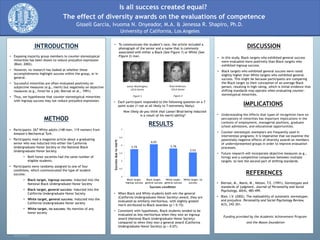More Related Content
Similar to posterpurc2015print
Similar to posterpurc2015print (20)
posterpurc2015print
- 1. RESEARCH POSTER PRESENTATION DESIGN © 2012
www.PosterPresentations.com
§ Black student inducted into the
Black Undergraduate Honor Society
§ Black student inducted into the
California Undergraduate Honor
Society
§ White student inducted into the
California Undergraduate Honor
society
§ White student not inducted into any
honor society
• Exposing majority group members to counter-stereotypical
minorities has been shown to reduce prejudice expression
(Blair, 2002).
• However, no research has looked at whether these
accomplishments highlight success within the group, or in
general.
• Successful minorities are often evaluated positively on
subjective measures (e.g., merit) but negatively on objective
measures (e.g., hired for a job; Biernat et al., 1991).
• Thus, we hypothesize that counter-stereotypical minorities
with ingroup success may not reduce prejudice expression.
INTRODUCTION
University of California, Los Angeles
Gissell Garcia, Ivuoma N. Onyeador, M.A. & Jenessa R. Shapiro, Ph.D.
Is all success created equal?
The effect of diversity awards on the evaluations of competence
METHOD
• Participants: 267 White adults (148 men, 119 women) from
Amazon’s Mechanical Turk.
• Participants read a magazine article about a graduating
senior who was inducted into either the California
Undergraduate Honor Society or the National Black
Undergraduate Honor Society.
• Both honor societies had the same number of
eligible students.
• Participants were randomly assigned to one of four
conditions, which communicated the type of student
success:
• Black target, ingroup success: Inducted into the
National Black Undergraduate Honor Society
• Black target, general success: Inducted into the
California Undergraduate Honor Society
• White target, general success: Inducted into the
California Undergraduate Honor society
• White target, no success: No mention of any
honor society
RESULTS
IMPLICATIONS
• Understanding the effects that types of recognition have on
perceptions of minorities has important implications in the
contexts of employment, managerial positions, graduate
school admissions, and educational opportunities.
• Counter-stereotypic exemplars are frequently used in
intervention programs; It is imperative that we examine the
potentially negative effects of diversity awards on members
of underrepresented groups in order to improve evaluation
processes.
• Future research will incorporate objective measures (e.g.,
hiring) and a competitive comparison between multiple
targets to test the second part of shifting standards.
DISCUSSION
• In this study, Black targets who exhibited general success
were evaluated more positively than Black targets who
exhibited ingroup success.
• Black targets who exhibited general success were rated
slightly higher than White targets who exhibited general
success. This might be because participants are comparing
the Black target to their conception of an average Black
person, resulting in high rating, which is initial evidence that
shifting standards may operate when evaluating counter-
stereotypical minorities.
• When Black and White students both win the general
(California Undergraduate Honor Society) award, they are
evaluated as similarly meritorious, with slightly greater
merit attributed to Black awardee (p = 0.15).
• Consistent with hypotheses, Black students tended to be
evaluated as less meritorious when they won an ingroup
award (National Black Undergraduate Honor Society)
compared to when they won a general award (California
Undergraduate Honor Society) (p = 0.07).
5.74
6.05
5.78
5.53
4
4.5
5
5.5
6
6.5
7
Black target,
ingroup success
Black target,
general success
White target,
general success
White target, no
success
Successduetomerit
Success condition
Lamar
Washington,
UCLA
Senior
Figure
1
Brad
Anderson,
UCLA
Senior
Figure
2
Funding provided by the Academic Achievement Program
and the Mason foundation
• Each participant responded to the following question on a 7
point scale (1-not at all likely to 7-extremely likely):
How likely do you think that Lamar/Brad being inducted
is a result of his merit/ability?
REFERENCES
• Biernat, M., Manis, M., Nelson, T.E. (1991). Stereotypes and
standards of judgment. Journal of Personality and Social
Psychology, 60(4), 485-499.
• Blair, I.V. (2002). The malleability of automatic stereotypes
and prejudice. Personality and Social Psychology Review,
6(3), 242–261.
• To communicate the student’s race, the article included a
photograph of the senior and a name that is commonly
associated with either a Black (See Figure 1) or White (See
Figure 2) man.
